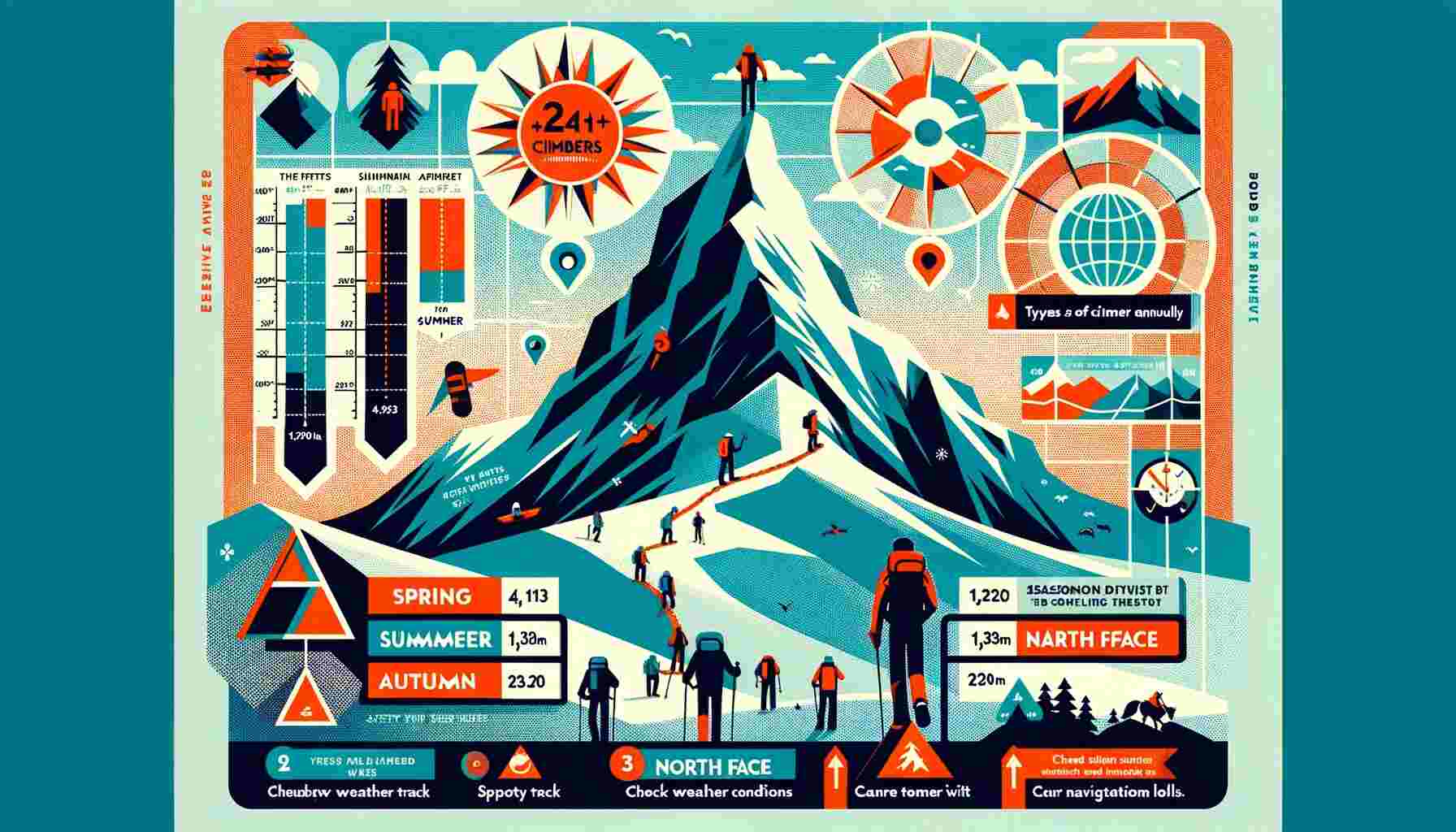Ben Nevis, towering at 4,413 feet (1,345 meters) above sea level, is the highest peak in the British Isles and a bucket-list destination for hikers and mountaineers. But when is the best time to conquer this majestic mountain?
Let’s explore the various factors that influence the ideal time to climb Ben Nevis, from weather conditions and seasons to personal preferences and safety considerations.
Understanding the Terrain
Before we delve into the best time to climb Ben Nevis, it’s crucial to understand the terrain you’ll be navigating. Ben Nevis is located in the Grampian Mountain range in Scotland and is characterized by its rugged, often snow-covered slopes. The mountain offers several routes to the summit, with the most popular being the Pony Track or the Tourist Path. Other routes, like the CMD Arete and the North Face, are more challenging and recommended for experienced climbers.
The terrain can be unforgiving, especially during the winter months, when heavy snowfall and icy conditions can make the ascent treacherous. It’s essential to be prepared for rapidly changing weather conditions and challenging terrain when planning your climb.
Seasons on Ben Nevis
The best time to climb Ben Nevis largely depends on the season, each offering its unique set of advantages and challenges.
1. Spring (March to May):
Spring marks the beginning of the climbing season on Ben Nevis. During this time, the snow begins to melt, revealing lush greenery and colorful wildflowers. The temperature is milder than in winter, and the days are getting longer, providing more daylight for your ascent.
Pros:
- Reduced snow cover makes for more accessible trails.
- Pleasant temperatures make hiking more comfortable.
- Stunning springtime landscapes with blooming flora.
Cons:
- Snow and ice may still be present on higher slopes.
- Unpredictable weather with the potential for rapid changes.
- Popular trails can get crowded.
2. Summer (June to August):
Summer is the busiest time on Ben Nevis, attracting hikers from all over the world. The snow has usually melted by this point, and the trails are at their most accessible. Longer daylight hours also allow for more extended hiking opportunities.
Pros:
- Warm temperatures and long daylight hours for extended hikes.
- Minimal snow and ice on the trails.
- Ideal for first-time climbers and families.
Cons:
- Crowded trails can lead to congestion, especially on the Pony Track.
- Frequent rain showers and unpredictable weather.
3. Autumn (September to November):
Autumn brings a beautiful transformation to Ben Nevis, with the landscape turning into a stunning tapestry of red, orange, and gold hues. The crowds thin out compared to the summer months, providing a quieter hiking experience.
Pros:
- Mild temperatures and fewer crowds.
- Stunning autumn foliage adds to the scenic beauty.
- More peaceful and serene hiking experience.
Cons:
- Days become shorter, reducing available daylight.
- The weather can be unpredictable, with the possibility of early snowfall.
4. Winter (December to February):
Winter on Ben Nevis is a true test of mountaineering skills. Snow and ice cover the slopes, creating a challenging environment for climbers. It’s essential to have proper gear and mountaineering experience if you plan to tackle Ben Nevis in winter.
Pros:
- Pristine snow-covered landscapes are a sight to behold.
- A true challenge for experienced mountaineers.
- Fewer crowds, providing solitude on the mountain.
Cons:
- Extreme cold and challenging weather conditions.
- Limited daylight hours can be a safety concern.
- Steeper trails with ice and snow require specialized equipment.
Related: Find Out How Long Does It Take to Climb Ben Nevis
Weather Considerations
Ben Nevis is notorious for its unpredictable weather, which can change rapidly and dramatically. Being prepared for varying weather conditions is crucial for a safe climb.
1. Rainfall:
Scotland is known for its rainy weather, and Ben Nevis is no exception. The mountain experiences rainfall throughout the year, with higher precipitation levels in the summer and autumn months. Ensure you have waterproof clothing and gear to stay dry during your climb.
2. Temperature:
Temperatures on Ben Nevis can range from mild to frigid, depending on the season. During the winter, temperatures can drop well below freezing, making proper insulation and warm clothing essential. Even in summer, it’s advisable to layer your clothing to adapt to temperature fluctuations.
3. Wind:
Strong winds are a common occurrence on Ben Nevis, particularly on the exposed ridges and summit. It’s essential to check the wind forecast before your climb and be prepared for gusty conditions. High winds can make the climb more challenging and pose a safety risk.
4. Fog and Low Visibility:
Ben Nevis frequently experiences fog and low visibility, especially on the higher slopes. Navigation can be challenging in these conditions, so it’s crucial to carry navigational equipment like maps, compasses, and GPS devices.
5. Snow and Ice:
During the winter months, snow and ice cover the mountain, making crampons and ice axes necessary for safe climbing. Even in spring and autumn, patches of snow and ice can linger on the higher slopes, so it’s wise to be equipped for such conditions.
Crowd Levels
The popularity of Ben Nevis means that it can get quite crowded during the peak climbing season, which is summer. If you prefer a quieter and more solitary experience, consider climbing during the shoulder seasons, such as spring or autumn. Winter, while less crowded, requires advanced mountaineering skills and equipment due to the challenging conditions.
Sunrise and Sunset
Climbing Ben Nevis during sunrise or sunset can be a magical experience. The play of colors in the sky and the panoramic views from the summit are truly breathtaking. However, it’s crucial to plan your climb carefully, as you’ll need to time your ascent and descent to coincide with these celestial events. Additionally, be aware that the weather conditions can be more extreme during the early morning or late evening.
Safety Precautions
Safety should always be a top priority when climbing Ben Nevis. Here are some essential safety precautions to consider:
1. Adequate Preparation:
Regardless of the season, make sure you are well-prepared for your climb. This includes having appropriate clothing, gear, and provisions. Check the weather forecast and be prepared for sudden changes.
2. Navigation Tools:
Carry navigational tools such as maps, compasses, and GPS devices to help you navigate in low visibility conditions. Familiarize yourself with the route beforehand.
3. Tell Someone Your Plans:
Before starting your climb, inform someone trustworthy about your plans, including your expected time of return. This way, someone will know to alert authorities if you don’t return as scheduled.
4. Group Size:
Consider hiking with a group or at least one partner, especially during the winter months or if you’re a less experienced climber. A group provides mutual support and can be invaluable in emergencies.
5. Emergency Contact:
Carry a fully charged mobile phone with emergency numbers saved. There is limited mobile signal coverage on the mountain, but it can still be a lifeline in case of emergencies.
6. Check Avalanche Warnings:
In winter, assess the avalanche risk and be cautious when climbing in areas prone to avalanches. Proper avalanche safety equipment and training are essential.
Special Considerations for Winter Climbing
Winter climbing on Ben Nevis is an entirely different experience and should only be attempted by experienced mountaineers who are properly equipped. Here are some additional tips for those considering a winter ascent:
1. Mountaineering Skills:
Make sure you have advanced mountaineering skills, including knowledge of snow and ice techniques, self-arrest, and the use of crampons and ice axes.
2. Avalanche Awareness:
Understand the risk of avalanches and how to assess avalanche conditions. Carry essential avalanche safety equipment, including transceivers, probes, and shovels.
3. Shorter Days:
Winter days are shorter, so plan your climb accordingly. Start early to maximize daylight and allow sufficient time for your descent.
4. Extreme Weather:
Be prepared for extreme cold and potentially harsh weather conditions. Dress in multiple layers and carry spare clothing in case of wetness or hypothermia.
5. Expert Guidance:
Consider hiring a certified mountain guide for a winter climb. They can provide valuable expertise and ensure your safety.

Climbing Ben Nevis: Popularity and Statistics
Ben Nevis, the towering peak that marks the highest point in the British Isles, beckons over 130,000 hikers annually to its rugged slopes. This staggering number not only highlights the mountain’s status as a premier hiking destination but also underscores its universal appeal to adventurers worldwide. From seasoned mountaineers to casual trekkers seeking to tick off a bucket-list challenge, Ben Nevis offers an array of experiences to a diverse audience.
The mountain’s allure is multifaceted, rooted in its majestic natural beauty, the physical challenge it presents, and the sense of accomplishment that comes from reaching its summit. Standing at 4,413 feet (1,345 meters), Ben Nevis commands respect and preparation from those who attempt its ascent, regardless of the chosen path—be it the accessible Pony Track or the more demanding CMD Arete and North Face routes.
The influx of climbers, particularly during the summer months, speaks volumes about the mountain’s magnetic pull. Yet, it also underscores the importance of considering the best time for your climb. The high visitor numbers can lead to congested trails, particularly on the Pony Track, suggesting that those seeking solitude or wishing to experience the mountain in quieter contemplation might favor the shoulder seasons of spring or autumn.
Incorporating this statistic into your understanding of Ben Nevis provides a broader perspective on what to expect in terms of crowd levels and the mountain’s seasonal dynamics. It serves as a reminder of the careful planning and respect for nature required when undertaking such an adventure, ensuring that your climb is not only memorable but also harmonious with the environment and fellow hikers.
Whether drawn by the challenge, the scenery, or the camaraderie found among like-minded outdoor enthusiasts, the significant number of annual climbers is a testament to Ben Nevis’s enduring appeal. As you prepare for your ascent, reflect on the shared experience of those tens of thousands of hikers who have traversed its paths before you, each with their own story of perseverance and discovery on Scotland’s most iconic peak. Here’s a great book to read.
Conclusion
The best time to climb Ben Nevis depends on your preferences, experience, and the type of adventure you seek. Spring and summer offer milder conditions and easier access to the summit, making them suitable for beginners and those who prefer more comfortable hiking. Autumn provides a quieter and more scenic experience, while winter challenges even the most experienced mountaineers with its extreme conditions.
Regardless of when you choose to ascend Ben Nevis, always prioritize safety, be well-prepared, and respect the unpredictable nature of the mountain. With the right planning and precautions, your Ben Nevis climb can be a truly unforgettable experience, offering breathtaking views and a sense of accomplishment that will stay with you forever. So, whether you’re chasing the summer sun or seeking a winter adventure, Ben Nevis awaits your ascent.








